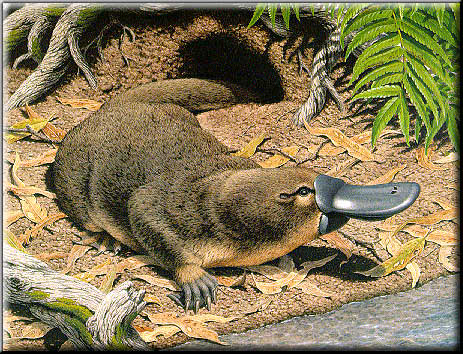


How to Draw a Platypus
Please PAUSE the video after each step to draw at your own pace (scroll down to see the final platypus drawing).
For the first few steps, don’t press down too hard with your pencil. Use light, smooth strokes to begin.
Step 1: Draw an oval as a guide for the platypus’ body. The oval doesn’t need to be perfect. It’s just a guide.
Step 2: Draw a smaller oval on the left side as a guide for the platypus’ head. This oval should be a little less than half the size of the body and should be placed right next to it.
Step 3: Draw a small arc on the left side as a guide for the first part of the platypus’ bill.
Step 4: Draw a thinner, longer arc on the left of that as a guide for the rest of the platypus’ bill.
Step 5: Draw a series of lines under the body as guides for the feet. For the platypus’ front foot, first draw a long diagonal line, then draw two smaller lines on the left and right. The foot in the back is just four small lines.
Step 6: On the right side of the body, draw a big arc similar to the letter U on its side as a guide for the platypus’ tail.
Step 7: Draw a couple of lines that connect the platypus’ head and body to form the neck.
That’s it for the initial sketch! From this point on, press harder with your pencil to get a more defined sketch.
Step 8: Draw the eye on the upper left side of the head. Draw the platypus’ eye as small circle and shade it in except for a tiny circle to represent glare. Use quick, short strokes to represent fur around it. Extend the fur toward the right to indicate where the platypus’ ear is.
Step 9: Use the two arcs as guides to draw the top part of the platypus’ bill. First draw an arc on the front that goes up on the face about as high as the eye. Then connect that arc to the long, front part of the mouth to form the top part of the bill. Draw a couple of small lines at the top for the platypus’ nostrils.
Step 10: Draw the lower part of the platypus’ bill using a couple more arcs on the bottom. The platypus uses its rubbery bill to find its prey with electrolocation.
Step 11: Darken the lines on the top and bottom for the platypus’ head.
Step 12: Use the initial lines as guides to draw the platypus’ front foot. Draw the base of the foot on the top part using quick, short strokes to represent fur. Thicken up the smaller lines to create the fingers. The platypus’ fingers are thin and should come to a point.
Step 13: Use the lines on the back as guides to draw the platypus’ hind foot. Draw a round base on the top part using quick, short strokes to represent fur. The hind feet have less webbing, so only draw a few curved lines in between the toes to indicate this. The platypus’ venomous spur is located on the inside of the foot, so it’s not visible here.
Step 14: Use the main oval and connecting lines to draw the platypus’ body. The tail should be thick because it’s where fat is stored, and it should come to a point at the end.
Step 15: Use the U-shaped arc on the back as a guide to draw the platypus’ tail. The tail should be thick because it’s where fat is stored, and it should come to a point at the end.
Step 16 (optional): You can stop here for a sketchy look or erase as much as you can of the initial guide lines for a cleaner look. Don’t worry about erasing all of them. It’s okay to leave some behind. Also re-draw any final sketch lines that you may have accidentally erased.
Step 17 (optional): Add some shading to your platypus drawing to give it more dimension and volume. Pick the direction of the light source when shading so that the shadows are consistent with it. Vary the pressure on your pencil to get different degrees of tonal value.
Step 18 (optional): Draw something underneath the platypus. This helps ground it so it doesn’t appear to be floating. A curved line along with smaller scattered lines work as a mount. Add some shading too.
Step 19 (optional): You can add more value throughout your platypusdrawing for extra detail. It’s a good idea to use reference to be as accurate as possible. Remember to PAUSE the video any time you need help along the way.


 (2 votes, average: 4.50 out of 5)
(2 votes, average: 4.50 out of 5)